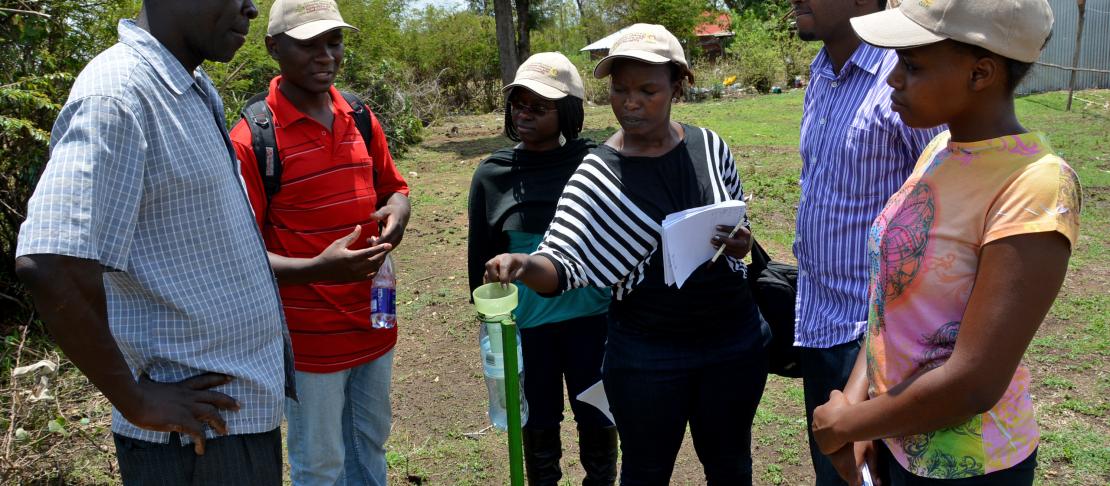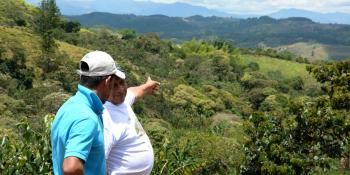Policy makers from Rwanda learn about community adaptation experiences

How can research on climate-smart agriculture inform investment decisions of national governments? See how policy makers are learning from research initiatives of farmers and partners in Western Kenya.
The number of hunger months experienced by families in the Nyando climate-smart villages in Western Kenya is falling. This has been attributed to a number of innovative climate risk management and adaptation strategies taken up by these farmers working closely with other partners for the last two years. Emerging lessons are being shared widely with stakeholders, among them policy makers.
From 30 March to 3 April, a team from the Ministry of Agriculture and Animal Resources in Rwanda undertook a learning visit of the Nyando CSVs to learn from ongoing initiatives. These officers are working under the International Fund for Agricultural Development (IFAD) supported Climate Resilient Post-Harvest and Agribusiness Support Project being implemented in Rwanda. This project aims to alleviate poverty, increase the incomes of smallholders and rural labourers – including women, youth and vulnerable groups – and contribute to overall economic development in Rwanda.
“We are interested to learn how collaborative efforts with the Kenya Meteorological Service (KMS) have helped develop downscaled seasonal climate forecast information and how to effectively communicate this information to farmers. Additionally we want to see how best to partner with local communities in order to enhance their adaptive capacity to climate change and variability “said Madeleine Usabyembabazi, Climate and Environmental Specialist, from Rwanda.
Climate risk management in Nyando, Kenya
The CGIAR Research Program on Climate Change, Agriculture and Food Security (CCAFS) East Africa together with Maseno University and other partners have been providing climate information services to Nyando farmers at the local level.
“The climate information services have three components which include holding pre-season seasonal climate outlook meetings, sending short-message-services of the weekly forecast and preparing products explaining crop-climate interaction for the region” says, Thomas Mawora, a climate scientist from Maseno University.
The team has used climate and crop models to analyze climate data and prepare the information to disseminate.
Read more: How can we help farmers better understand climate information?
Historical climate information
The analysis of long-term historical rainfall data to generate products such as graphs of total seasonal rainfall, number of rainy days and start of season for different years was shared.
“We engage farmers in working groups for analysis and discussion of the historical rainfall data. This way, farmers get to appreciate variability in the different aspects such as start of rains and the seasonal totals” explained John Gathenya, one of the partners in this project based at the Jomo Kenyatta University of Agriculture and Technology (JKUAT).
The Rwandese delegates further learnt how farmers collect, record and manage the rainfall data using rain gauges erected on their farms. Since this data showed a lot of variability, between both nearby farms and the further KMS meteorological station, downscaled products had to be developed for precision in the forecasting that would help reduce the risk of crop failure.
Partnerships and dissemination of climate data
The visitors also learnt how the climate outlook was summarized and presented to farmers. Discussions showed that with a proper strategy, disseminating weekly forecasts to key farmers would help many prepare for in-season shocks or opportunities at very low cost. Already, Maseno University has sent out over seven hundred weekly messages - seven day forecasts - which farmers use in making farm decisions. Furthermore, extension officers from the Ministry of Agriculture, Livestock and Fisheries (MoALF) regularly meet farmers to discuss climate challenges facing them and their crop.
Nyando’s smart farms
During a visit to Kapsokale Community Based Organization smart farm, the guests met youth groups farming on half hectare fields. Interventions included rainwater harvesting, conserving soil fertility and organic components, green house farming and crop diversification to reduce risks associated with climate change. These farms serve as demonstration sites for youth and women groups engaged in agriculture. Due to the nature of the intensive knowledge and skills required to operate the greenhouse production units, youth groups are trained as part of the process of advancing local adaptation actions.
In conclusion, researchers, farmers and government officers working in Nyando and other CSVs continue to monitor and evaluate the various enterprises with an aim to scale up and share emerging lessons widely. Currently, training manual on participatory approaches for use of climate information services by farmers” is being developed in collaboration with the University of Reading. This manual will be ready later in the year and will share some of the lessons.
Further reading:
- Inspiring action: Nyando climate-smart villages host policy makers
- How climate-smart farming in Kenya influences better policy-making
- Photo-story: From farm-plot to climate policy progress for East Africa
- Learn about University of Reading's climate information services PICSA project: Putting farmers at the centre of climate information services
Phillip Kimeli is a Research Assistant with CCAFS East Africa, Thomas Mawora is a Tutorial Fellow at Maseno University, Kenya, John Gathenya is a Climate Change Research Fellow at the Walker Institute for Climate System Research.



